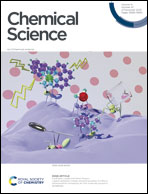Synthesis of substituted benzylboronates by light promoted homologation of boronic acids with N-sulfonylhydrazones†
Abstract
The synthesis of benzylboronates by photochemical homologation of boronic acids with N-tosylhydrazones under basic conditions is described. The reaction involves the photolysis of the N-tosylhydrazone salt to give a diazoalkane followed by the geminal carboborylation of the diazoalkane. Under the mild reaction conditions, the protodeboronation of the unstable benzylboronic acid is circumvented and the pinacolboronates can be isolated after reaction of the benzylboronic acid with pinacol. The metholodogy has been applied to the reactions of alkylboronic acids with N-tosylhydrazones of aromatic aldehydes and ketones, and to the reactions of arylboronic acids with N-tosylhydrazones of aliphatic ketones. Moreover, the employment of the DBU/DIPEA bases combination allows for homogeneous reactions which have been adapted to photochemical continuous flow conditions. Additionally, the synthetic versatility of boronates enables their further transformation via Csp3–C or Csp3–X bond forming reactions converting this methodology into a novel method for the geminal difunctionalization of carbonyls via N-tosylhydrazones.

- This article is part of the themed collections: 2023 Chemical Science HOT Article Collection and #MyFirstChemSci 2023


 Please wait while we load your content...
Please wait while we load your content...